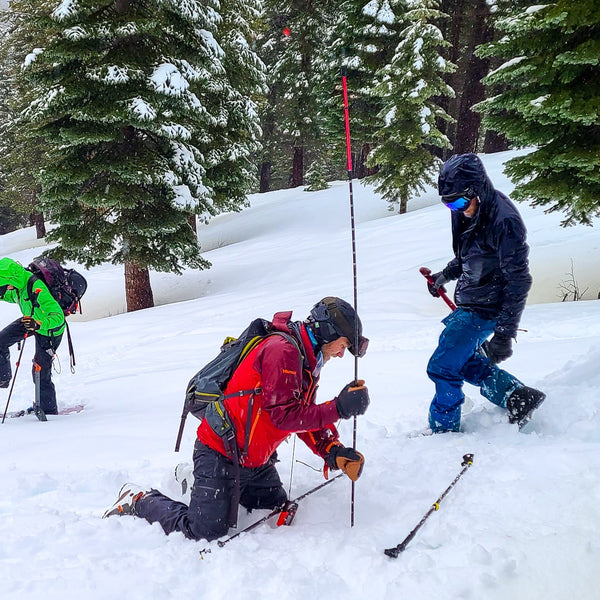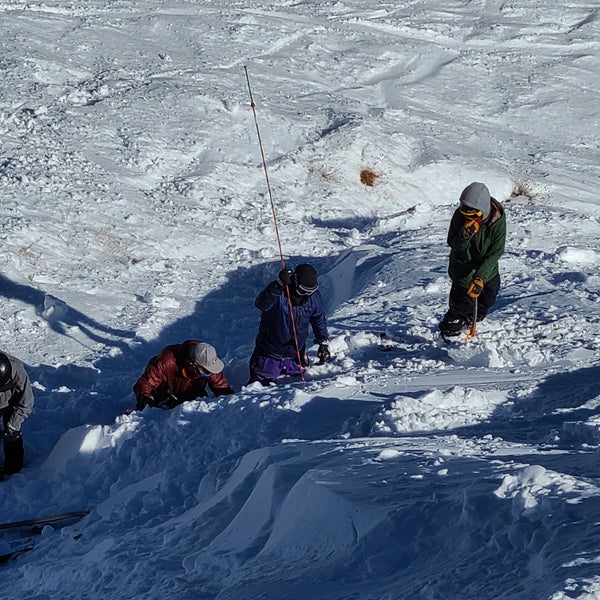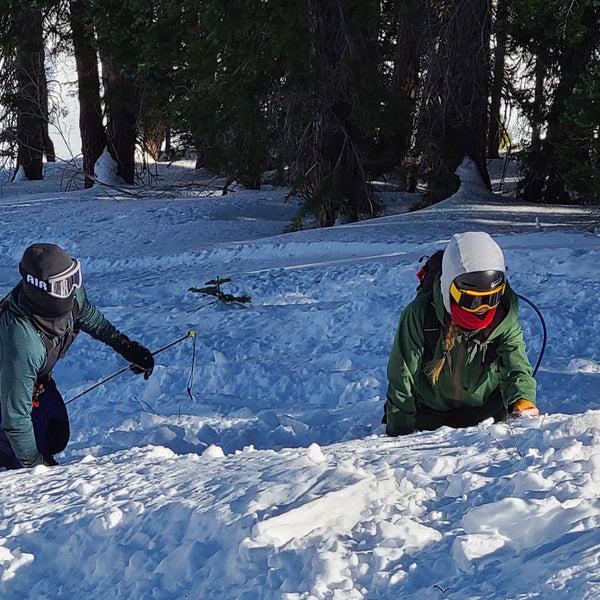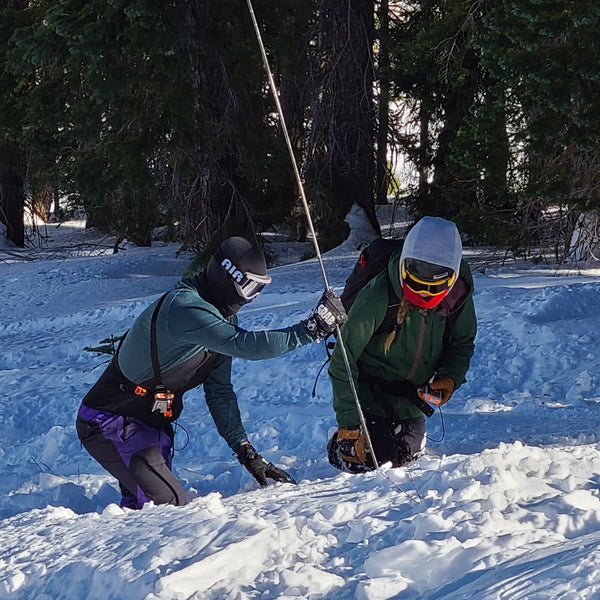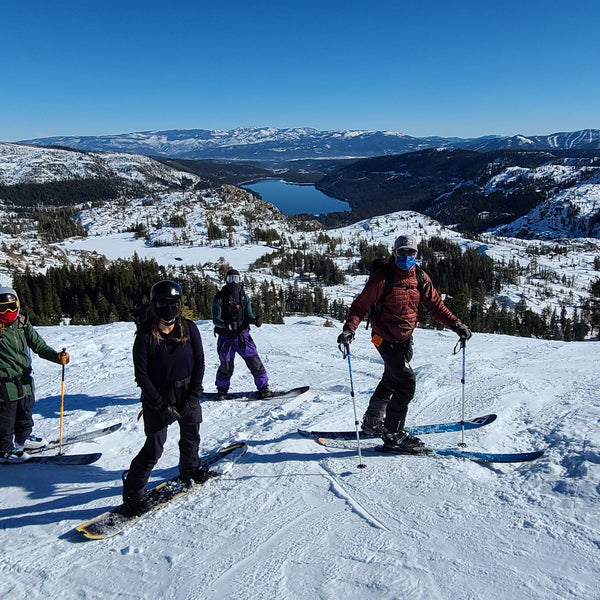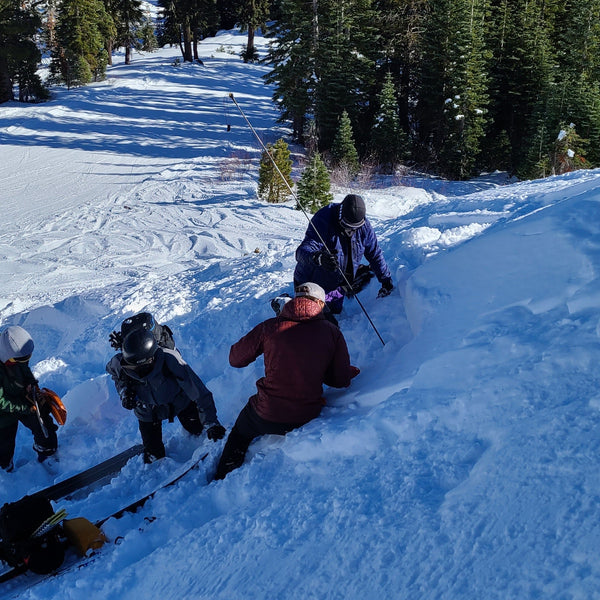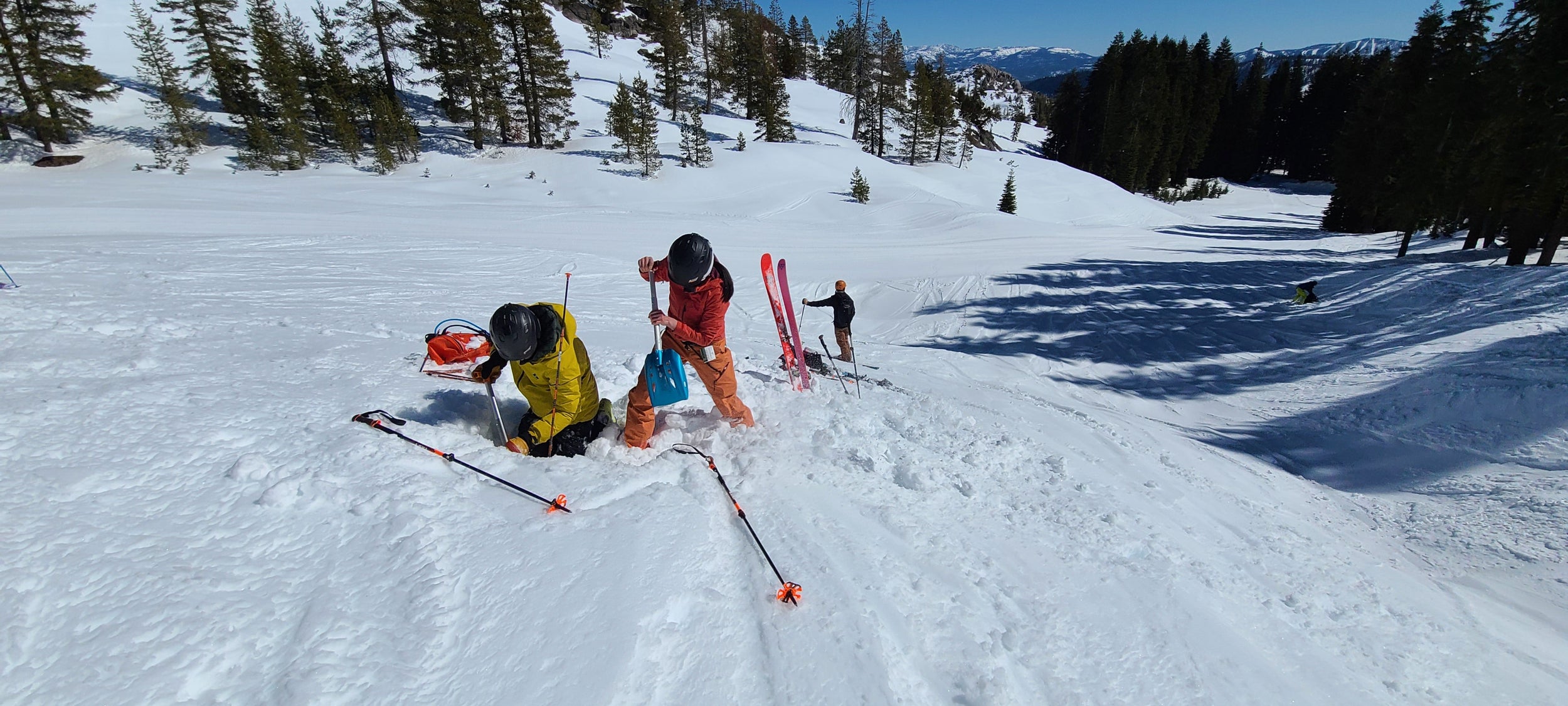
AIARE Avalanche Rescue Course in Mammoth
We'll cover the following topics and skills:
- What to do if you're caught in an avalanche
- What to do if your partner is caught in an avalanche
- How to use your beacon, shovel and probe
- Rescue equipment technology
- Rescue techniques for companion and small team rescue
- How terrain affects an avalanche rescue and how to use terrain to your advantage
- Visual search, transceiver search and spot probing
- Strategies for using your gear effectively
Frequently Asked Questions
Why choose an AIARE Rescue Avalanche course in Mammoth?
-
Mammoth is an ideal location for an Avalanche Rescue course due to its consistent snowfall, high-elevation terrain, and diverse avalanche-prone landscapes. The area’s open bowls, steep chutes, and tree-lined slopes offer realistic settings for practicing critical rescue techniques, such as beacon searches, probing, and efficient digging methods.
Mammoth’s deep, layered snowpack provides valuable hands-on experience with varied snow conditions, while its frequently changing weather patterns help students learn to adapt rescue skills to different scenarios. This dynamic environment ensures participants leave with a well-rounded and practical understanding of avalanche rescue.
Why choose Blackbird Mountain Guides for your AIARE Avalanche Rescue course?:
-
Choosing Blackbird Mountain Guides for your AIARE Avalanche Rescue course means learning from some of the most experienced and dedicated avalanche professionals in the industry. Blackbird’s instructors are seasoned backcountry guides with extensive hands-on experience in diverse avalanche terrain. We prioritize small group sizes, which allows for personalized instruction and in-depth practice of critical rescue skills, including beacon searches, probing, and efficient shoveling techniques.
We are also the #1 AIARE course provider in the U.S., committed to the highest standards of safety and education. With Blackbird, you gain practical knowledge, confidence, and skills to handle avalanche rescue situations, supported by a team that’s dedicated to your growth and safety in the backcountry.
For more info check out our blog post about what makes Blackbird's AIARE courses different.
This program requires at least 3 participants to run.
Here's the schedule for your course:
- 8:30 am - Meet your guide at the trailhead
- 9:00 am - Cover fundamental avalanche rescue skills
- 10:30am -3:00pm - Instructor rescue demo and participant led scenarios
- 3:00-3:30 - Course ends
Here are the skills and fitness you'll need for your course:
- Advanced Resort Riding skills - Including off-piste terrain in challenging snow conditions
- Basic Backcountry Touring Skills - Including familiarity with equipment and avalanche gear.
- Basic Fitness - Able to spend an active day outside, moving uphill at 1,000’ per hour for durations of roughly 1 hour between breaks. Participants should be able to hike 3-5 miles and climb 1,000-1,500 vertical feet throughout the course of the day.
- Ski/Split Touring & Avalanche Gear - Come prepared with your own gear or rent from us
The AIARE Rescue Course can be taken either before OR after the AIARE 1 Course
Here's what's included with your course:
- Experienced AMGA/AIARE Trained Guide
- Group Safety Gear - your guide will be equipped with snow science tools and a first aid kit
- Wag Bags - for human waste disposal in with compliance 'Leave No Trace' principles
- Ski/Splitboard Gear
- Avalanche Gear
- Guide Gratuities
Eastern Sierra Backcountry Skiing Gear List
- Avalanche Gear - Come prepared with your own gear or rent from Blackbird
- Ski Touring Gear - Come prepared with your own gear or rent from Mammoth Mountaineering
Know Before you go

PRIVATE PROGRAMS
- Custom Scheduling: Choose your dates and plan around your availability.
- Tailored Experiences: Itineraries and objectives are adjusted to suit your goals, experience, and fitness.
- Cost-Effective for Most Large Groups: Private programs are typically more cost-effective for groups of 3 or more.
- Flexibility Comes at a Price: For groups of 1-2, private programs are generally more expensive.
- AIARE Courses: AIARE course pricing is based on a group of 6. Running these as a private program with fewer than 6 participants will increase the per-person cost.
SCHEDULED PROGRAMS
- Fixed Dates & Costs: Scheduled programs have set dates, itineraries, objectives, and pricing.
- Great for Solo or Small Groups: Ideal for individuals or small groups looking to share costs with others.
- Affordable for 1-2 People: Scheduled programs are typically less expensive for groups of 1-2.
- Less Flexibility: Dates fill quickly, and group programs require adapting to the skill level and pace of all participants
- Group Atmosphere: Meet others with similar interests and make some new backcountry buddies!
Note: Any scheduled program can also be run as a private program with customized dates and rates.
Both options offer exceptional guiding and experiences. Choose what works best for you!
AIARE Avalanche Rescue Course Itinerary
8:30 am Meet your guide at Donner Ski Ranch
9:00 am Load the ski lifts and cover fundamental skills
10:30am -3:00pm Instructor rescue demo and participant led scenarios
3:00-3:30 Course close
We'll cover the following topics and skills:
- What to do if you're caught in an avalanche
- What to do if your partner is caught in an avalanche
- How to use your beacon, shovel and probe
- Rescue equipment technology
- Rescue techniques for companion and small team rescue
- How terrain affects an avalanche rescue and how to use terrain to your advantage
- Visual search, transceiver search and spot probing
- Strategies for using your gear effectively
Frequently Asked Questions
Why choose an AIARE Rescue Avalanche course in Mammoth?
-
Mammoth is an ideal location for an Avalanche Rescue course due to its consistent snowfall, high-elevation terrain, and diverse avalanche-prone landscapes. The area’s open bowls, steep chutes, and tree-lined slopes offer realistic settings for practicing critical rescue techniques, such as beacon searches, probing, and efficient digging methods.
Mammoth’s deep, layered snowpack provides valuable hands-on experience with varied snow conditions, while its frequently changing weather patterns help students learn to adapt rescue skills to different scenarios. This dynamic environment ensures participants leave with a well-rounded and practical understanding of avalanche rescue.
Why choose Blackbird Mountain Guides for your AIARE Avalanche Rescue course?:
-
Choosing Blackbird Mountain Guides for your AIARE Avalanche Rescue course means learning from some of the most experienced and dedicated avalanche professionals in the industry. Blackbird’s instructors are seasoned backcountry guides with extensive hands-on experience in diverse avalanche terrain. We prioritize small group sizes, which allows for personalized instruction and in-depth practice of critical rescue skills, including beacon searches, probing, and efficient shoveling techniques.
We are also the #1 AIARE course provider in the U.S., committed to the highest standards of safety and education. With Blackbird, you gain practical knowledge, confidence, and skills to handle avalanche rescue situations, supported by a team that’s dedicated to your growth and safety in the backcountry.
For more info check out our blog post about what makes Blackbird's AIARE courses different.
This program requires at least 3 participants to run.
Here's the schedule for your course:
- 8:30 am - Meet your guide at the trailhead
- 9:00 am - Cover fundamental avalanche rescue skills
- 10:30am -3:00pm - Instructor rescue demo and participant led scenarios
- 3:00-3:30 - Course ends
Here are the skills and fitness you'll need for your course:
- Advanced Resort Riding skills - Including off-piste terrain in challenging snow conditions
- Basic Backcountry Touring Skills - Including familiarity with equipment and avalanche gear.
- Basic Fitness - Able to spend an active day outside, moving uphill at 1,000’ per hour for durations of roughly 1 hour between breaks. Participants should be able to hike 3-5 miles and climb 1,000-1,500 vertical feet throughout the course of the day.
- Ski/Split Touring & Avalanche Gear - Come prepared with your own gear or rent from us
The AIARE Rescue Course can be taken either before OR after the AIARE 1 Course
Here's what's included with your course:
- Experienced AMGA/AIARE Trained Guide
- Group Safety Gear - your guide will be equipped with snow science tools and a first aid kit
- Wag Bags - for human waste disposal in with compliance 'Leave No Trace' principles
- Ski/Splitboard Gear
- Avalanche Gear
- Guide Gratuities
Eastern Sierra Backcountry Skiing Gear List
- Avalanche Gear - Come prepared with your own gear or rent from Blackbird
- Ski Touring Gear - Come prepared with your own gear or rent from Mammoth Mountaineering
Epic Reviews From Adventurers
the blackbird difference
We’re here to help. Our FAQs or Gear Lists might have the information you’re seeking. But If you’re not finding the information you need, we’d be happy to help!

